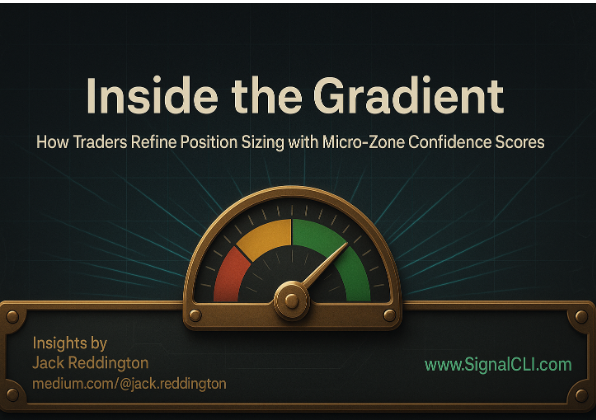Why Gradients matter
In modern trading, direction alone isn’t enough. Even within a published daily schedule, quality can vary minute to minute. Gradients are the confidence layer on top of Zone grading—a way to measure how strong or weak a trading window is. For professionals, they answer the question: is this moment clean enough to commit full size, or does it demand caution?

The anatomy of a Gradient
Every crypto futures signal already carries a Zone label: Green Zone (favorable), Yellow Zone (caution), or Red Zone (avoid). Gradients refine those labels with percentages. Green 100% means the period has behaved consistently well. Green 85/15 means the window has shown some Yellow-like behavior historically it’s still Green, but caution is advised. In short, Gradients turn a blunt label into a sliding scale.
How professionals apply Gradients
Traders treat Gradients as position-sizing dials. Full base size in strong Green. Smaller allocation in weaker Green or favorable Yellow. Zero allocation in Red. Instead of guessing, they apply rules: higher confidence, larger size; lower confidence, smaller size. Over time this preserves capital in weak conditions and compounds gains when the tape is clean.
Why Gradients cut noise
One of the biggest drivers of overtrading is treating every signal equally. Gradients stop that. When a weak Gradient appears, many professionals either pass or cut size dramatically. That discipline lowers fee drag, reduces stress, and makes logs easier to audit. Passing is not a missed opportunity—it’s a strategic choice that improves long-run results.
What Gradients are not
Gradients are not new signals. They don’t predict headlines, decode project roadmaps, or manage risk for you. They only measure historical and live quality within Zones. Traders still interpret macro events, monitor whale activity, and decide whether external context overrides the Gradient. Automation handles the math. Humans provide the judgment.
Why transparency matters
For Gradients to add value, providers must publish them openly. A clear readout 100% Green, 90/10 Green/Yellow, 70/30 Yellow/Red — gives traders actionable information. Without transparency, “Gradient” is just a marketing buzzword. With it, it becomes a measurable edge.
What traders report
Early users say Gradients simplify decision-making. Instead of debating whether a session is truly clean, they follow the score. Routine becomes simple: check Zone, check Gradient, decide. Weekly reviews then show not just win rates but which Gradients contributed most to performance. That clarity reduces second-guessing and strengthens discipline.
Key takeaways
- Gradients refine Zone grading with confidence scores.
- Professionals use them as sizing controls, scaling up or down based on quality.
- They help prevent overtrading and cut fee drag by encouraging discipline.
- They don’t replace judgment—macro awareness and risk rules remain critical.
- Transparency separates real Gradients from empty labels.
Why it matters now
Markets are more competitive than ever. Marginal edges — like knowing which Green windows deserve size and which don’t can define outcomes. Signals, schedules, and Zones provide the foundation. Gradients add nuance. Together they create a process that lets traders act with consistency instead of impulse. Businesses and individuals who adopt this layered approach are better equipped to navigate volatility with discipline.
About SignalCLI
SignalCLI is a crypto futures signals provider focused on clarity, precision, and informed decision-making. Using a combination of established technical indicators, Smart Money Concepts, and advanced AI analysis, SignalCLI delivers structured, data-driven insights to help traders identify high-probability setups in fast-moving markets. The service is designed for those who value disciplined execution, risk awareness, and timing over speculation. For deeper insights and practical examples, visit www.signalcli.com and explore Jack Reddington’s Medium for trading strategies, market breakdowns, and educational articles.

